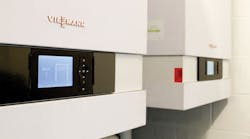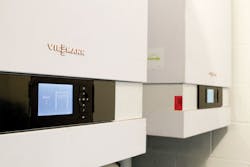At Canterbury Apartment Homes in Nashua, N.H., each of 16 30-unit buildings was served by four boilers and one 50-gal. domestic-hot-water tank installed in 1972. During the long New England winters, the boilers ran 24/7, frequently breaking down at seemingly the least convenient times and generating as many as seven or eight service calls a day—or night. Maintenance crews replaced 12 to 15 circulators—at a cost of $400 to $700 each—every season. Worse, the inadequate supply of hot water frustrated tenants, leading to high resident turnover. Fuel expenses, carried by the community owners, compromised profits.
Canterbury had two objectives: lower fuel consumption and reduce maintenance expenditures. Management considered seven vendors. After a boiler-room survey and a commercial-product evaluation, Canterbury chose two Viessmann Vitodens 200-W, B2HA 150 wall-mounted, gas-fired condensing boilers and two 79-gal. Vitocell 300-B dual-coil indirect hot-water tanks for each building.
Constructed around an exchanger crafted from the highest-quality titanium/stainless steel available, the boilers, with the incorporation of three-way mixing valves that control the temperature of return water, are able to capture as much as 8,000 Btu of “free” heat from every gallon of condensate, contributing to a combustion-efficiency rating of 93 percent. The Lambda Pro combustion system continuously monitors flame quality, automatically adjusting both fan speed and the gas valve to accommodate variations in fuel quality. With the use of digital controls, Canterbury can shape the heating curve—the ratio of increase in boiler temperature to the decrease in outside-air temperature—for maximum efficiency. In its first year, Canterbury has been able to move the curve to 1.5 without any resident discomfort; management anticipates it will be able to drop it to 1.2 next year.
With dual coils, the Vitocell hot-water tanks will be able to accommodate future solar inputs easily. Thanks to reverse-return piping, each building’s two tanks share the load evenly, reducing the strain on any one tank.
Installation began in late September/early October 2013 and was completed by Thanksgiving. Even though the system did not serve a complete season, Canterbury enjoyed a 15-percent reduction in fuel costs and expects savings—because of the sophistication of the systems’ digital sensors and controls—of as much as 30 percent in years to come. Maintenance calls and hot-water complaints, once a mainstay of the winter season, have stopped. With additional investments in insulation, replacement windows, and other energy-saving initiatives, Canterbury expects a much greener—and less expensive—future for itself and its residents.
For Design Solutions author guidelines, call Scott Arnold, executive editor, at 216-931-9980, or write to him at [email protected].











